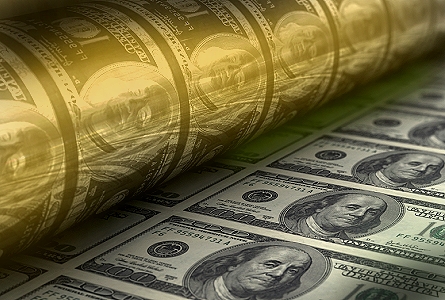By Mark Ferguson for CoinWeek – MFRareCoins.com
If you’re an investor who believes high inflation is just around the corner and who sees rare coins as a terrific inflation hedge, as they’ve been in the past, now’s a great time to get into the coin market. After a block buster World’s Fair of Money trade show, produced by the American Numismatic Association in Chicago in August, the rare coin market has simmered down a little. Gold has backed way off its $1900 per ounce high seen at that time, softening outside investor psychology for gold and rare coins. However, there’s still a huge pent up demand from those in the know for high end premium quality rare coins. But while trading has been tempered a little, it is still very active and a good time to buy.
 Back during the 1970s, when we went through our last high inflationary period, during the Jimmy Carter years, investors were throwing money at coin dealers saying, “Buy me some rare coins.” The market exploded, sending some coins that could be bought for less than $300 dollars in 1977 to nearly $3,000 in 1980 – really! And this was not the exception – it was typical! Market values became distorted as the investor-driven coin market veered away from the fundamentals that make the market what it is – a collector-based market.
Back during the 1970s, when we went through our last high inflationary period, during the Jimmy Carter years, investors were throwing money at coin dealers saying, “Buy me some rare coins.” The market exploded, sending some coins that could be bought for less than $300 dollars in 1977 to nearly $3,000 in 1980 – really! And this was not the exception – it was typical! Market values became distorted as the investor-driven coin market veered away from the fundamentals that make the market what it is – a collector-based market.
Huge overall dealer profits were also reinvested into rare coins at that time, further fueling the coin market, because after all, that’s what we know and do with our money as coin dealers – invest in inventory. After those heady days, the coin market did experience a bubble, but only after fortunes were made in the coin market. Those who lost got in late or took a flyer, not knowing what they were doing. Learning about the coin market is the key to success.
Will a runaway coin market happen again? It very well could, and we have much more positive fundamentals going for the coin market this time around. During the mid-1980s, PCGS, the Professional Coin Grading Service, and NGC, Numismatic Guaranty Corporation, were formed. Today they are the backbones of this industry in terms of coin grading, which is one of the fundamental basics for valuing rare coins. This has led to much strengthened consumer protection and confidence in owning rare coins, unlike the days prior to this era when individual coin dealers would grade their own coins they had for sale. It’s easy to see the abuses and legitimate differences of opinion dealers and collectors had during those days of self-grading, which were based on individual interpretations of standards outlined in coin grading guides.
PCGS and NGC have also given collectors, investors, and even dealers, more confidence in owning expensive rare coins, and because of those services it’s much easier for everyone, these days, to buy and sell coins. However, third-party certified coin grading has also allowed inexperienced coin dealers to quickly enter the market and set up shop. So, choose your dealer wisely. Additionally, on the wholesale or dealer-to-dealer side of the coin market, there are dealers who are market makers for certain coins. This was true before the advent of certified coin grading, but, unlike those days, today some of these market makers will buy many rare coins on a “sight-unseen” basis, without even looking at them, just by relying on the certified grades assigned by the grading services. This isn’t true of all certified rare coins, but this factor is present in the market for certain select rare coins.
Another huge factor in the coin market, that’s become a great backbone of the industry, that wasn’t around for the public during the 1970s, is the Internet. This tool has given collectors and investors a great information resource for learning about rare coins that the market didn’t have during the last inflation-investment surge. It’s also facilitated much greater coin trading online via auctions and inventory offerings for dealers and even collectors who have been enabled to sell their coins themselves online. But there’s a learning curve for new collectors and investors, and even experienced collectors who want to venture into new areas of collecting. What greater resource could there be for this information besides the Internet? Again, the coin market didn’t have this beneficial tool during the inflationary investor market of the 1970s.
Coin price guides have also improved since that time, and the Internet has also given collectors, investors, and dealers another great tool for research – an easy way to access auction records of rare coins. However, sometimes researching auction records is an easy task and sometimes it takes much sophistication in knowing what’s going on in the coin market. As the market analyst who established values for all rare coins for the largest price guide in the industry during the bull market in coins in the 2000s, I believe rare coin pricing is the next frontier to be perfected, as best as it can be, during the coming years, much in the same as coin grading has been perfected since the mid-1980s. Again, for the best help, know your dealer and his or her experience level.
So, while not absolutely perfect, the rare coin market is probably the most structured and efficient of all the collectible, inflation-hedge markets in existence. People can trade rare coins within a fairly narrow trading range, compared to other collectibles, and there has always been a ready market for coins at some price level, even in a down market. Rare coins have always been very liquid at the right price points.
Of course, as a life-long dealer in rare coins, who’s also had a couple of career digressions, into coin grading for PCGS and coin pricing for Coin Values magazine, I’m biased toward the rare coin market. But take a look at stock brokers and real estate brokers, for example. They’re biased toward their own areas of endeavor and often talk down other markets, like rare coins and precious metals. What are we hearing today? “The gold bubble has burst!” But haven’t we been hearing this from traditional investment advisors during the last ten years as the gold price has continued to climb, outperforming most traditional investments?
Yes, the gold bubble probably will burst at some time in the future, and maybe it will again for rare coins, but only after the economy goes through the coming inflationary years and fundamental changes are made to reduce the world-wide debt bubble. But until those days are upon us, rare coins will likely prove to be a great inflation hedge during the coming years. Government spending cutbacks are what are needed, but we haven’t seen Congress develop the backbone and cohesiveness to pull this off. Reduced living standards and protests will result with the needed cutbacks, and even banking and housing crises and social protests might occur before the needed austerity measures are taken. Sound familiar? We’re already seeing the beginning of all that.
The federal debt is continuing to grow. Deficit spending is occurring every year, adding to this debt, and the temporary way out of this problem, to contain social unrest and financial crises, has been to print more money. Clearly this can’t continue indefinitely, but it likely will for years to come, creating progressively higher future inflation. It’s already starting. As I’m writing this, today’s Wall Street Journal, for example, contained several reports of higher inflation in this country and around the world. Gold and rare coins have served as stellar inflation hedges during inflationary spiral, like the one we’re entering now.
 Mark Ferguson was a coin grader for PCGS , a market analyst for Coin Values and has been a coin dealer for more than 40 years. He has written for the ANA, Coin Dealer Newsletter, Coin World, Numismatic News, , Coin Values, The Numismatist and currently has a weekly column on CoinWeek. Mark can be reached at Mark Ferguson Rare Coins ( www.mfrarecoins.com)
Mark Ferguson was a coin grader for PCGS , a market analyst for Coin Values and has been a coin dealer for more than 40 years. He has written for the ANA, Coin Dealer Newsletter, Coin World, Numismatic News, , Coin Values, The Numismatist and currently has a weekly column on CoinWeek. Mark can be reached at Mark Ferguson Rare Coins ( www.mfrarecoins.com)




